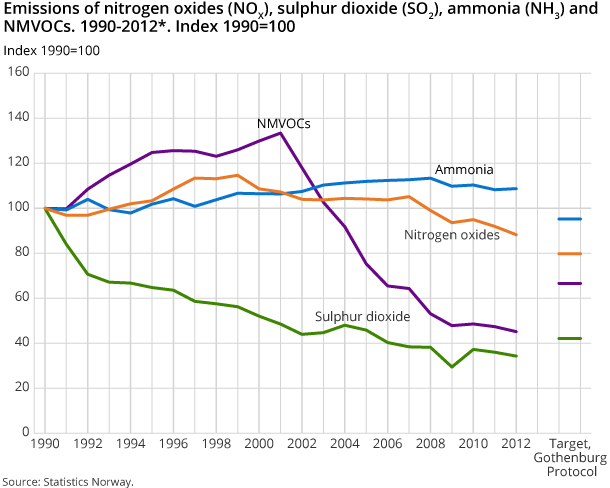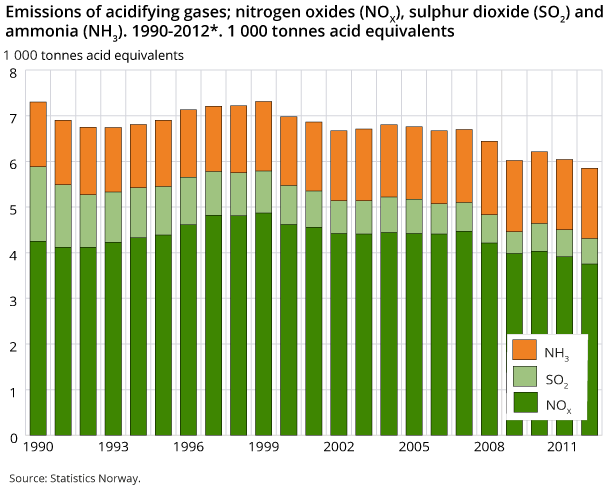Content
Published:
This is an archived release.
Acidifying emissions down 3 per cent in 2012
Norway’s emissions of the acidifying substances NO X , SO 2 and NH 3 , measured as acid equivalents, were reduced by 3 per cent in 2012 according to preliminary figures.
| 2012 | Change in per cent | ||
|---|---|---|---|
| Since 1990 | 2011 - 2012 | ||
| 1Does not include international sea and air traffic. | |||
| Nitrogen oxides (NOX) | 173 | -11.7 | -4.0 |
| Sulphur dioxide (SO2) | 18 | -65.7 | -4.8 |
| Ammonia (NH3) | 26 | 8.7 | 0.4 |
| Non-methane volatile organic compounds (NMVOC) | 132 | -54.8 | -4.7 |
| Carbon monoxide (CO) | 298 | -60.2 | -4.4 |
The preliminary figures show that nitrogen oxides (NO X ) and sulphur dioxide (SO 2 ) contributed most to the decrease in emissions of acidifying substances , while the emissions of ammonia (NH 3 ) remained practically unchanged from 2011.
The emissions of non methane volatile organic compounds (NMVOC) and carbon monoxide (CO) were also reduced, by 4.7 and 4.4 per cent respectively.
Reduced NO X emissions from coastal traffic and ferro alloys
Total estimated emissions in 2012 were 172 510 tonnes, compared to 179 715 tonnes in 2011. Coastal traffic and production of ferro alloys contributed most to this reduction. Aviation and fishing vessels had a slight increase in emissions. Total emissions were 10.6 per cent above the target of the Gothenburg Protocol .
Less SO 2 from manufacturing industries, more from oil refining and coastal traffic
SO 2 emissions were reduced from 18 830 tonnes to 17 935 tonnes from 2011 to 2012. Reduced emissions from production of ferro alloys and carbides were most important for this decline. Among the sectors that had an increase, oil refining and coastal traffic had the biggest absolute increase. Total emissions were 18.5 per cent lower than the target of the Gothenburg Protocol.
NH 3 emissions unchanged
The total emissions of NH 3 remained practically unchanged from 2011 to 2012. Road traffic emissions were reduced by 8 per cent, while agriculture, which is the dominating source with 92 per cent of national emissions, had a slight increase. Total emissions in 2012 were estimated at 26 260 tonnes, and this is 14.2 per cent above the target in the Gothenburg Protocol.
Continued reductions of NMVOC emissions from oil and gas extraction
The emissions of NMVOC continued to fall in 2012. Reduced emissions from oil loading offshore were the most important contribution to the 15 per cent reduction from oil and gas extraction in 2012.
A more detailed presentation of emission by source and sector is given in the release of final figures 1990-2011 .
Detailed information in February 2014Open and readClose
The figures presented here are preliminary, and revised figures will be published in February 2014, together with more detailed figures by source and economic sector.
The statistics is published with Emissions to air.
Contact
-
Statistics Norway's Information Centre
E-mail: informasjon@ssb.no
tel.: (+47) 21 09 46 42


